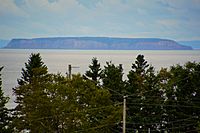Isle Haute facts for kids
|
Native name:
Maskusetik
|
|
|---|---|

Image taken at low tide at Harbourville, Nova Scotia
|
|
| Lua error in Module:Location_map at line 420: attempt to index field 'wikibase' (a nil value). | |
| Etymology | "High Island" (Samuel de Champlain, 1604) |
| Geography | |
| Location | Bay of Fundy |
| Area | 83 ha (210 acres) |
| Length | 3 km (1.9 mi) |
| Width | 400 m (1,300 ft) |
| Highest elevation | 100 m (300 ft) |
| Administration | |
|
Canada
|
|
| Demographics | |
| Population | 0 |
| Additional information | |
| Time zone |
|
| A Fundy Island's Story", Gulf of Maine Times Autumn 2002 | |
Isle Haute is a special island located in the upper part of the Bay of Fundy in Nova Scotia, Canada. It sits near the entrance to the Minas Basin. The island is about 16 kilometers (10 miles) from Harbourville. It is also about eight kilometers (5 miles) south-southwest of Cape Chignecto.
Isle Haute is part of Cumberland County, Nova Scotia. The island is about three kilometers (1.9 miles) long and 400 meters (1,300 feet) wide.
About Isle Haute
Isle Haute is known for its tall, steep cliffs. These cliffs are about 100 meters (330 feet) high. They are made of a rock called basalt. This rock was formed from volcanic eruptions that happened a very long time ago. This was during the Jurassic period. Scientists think the island might have been connected to the North Mountain volcanic ridge on the mainland. This was about 200 million years ago, before the Bay of Fundy was created.
Island History
Long before Europeans arrived, the Mi'kmaq people used Isle Haute. They called the island "Maskusetik." This name means "place of wild potatoes." The Mi'kmaq used the island to make tools from stone.
In 1604, a French explorer named Samuel de Champlain visited the island. He saw its towering cliffs, trees, and fresh-water springs. He named it "Isle Haute," which means "High Island" in French.
The Lighthouse
A lighthouse was built on Isle Haute in 1878. Lighthouse keepers lived and worked there, making sure ships were safe. In 1956, a fire destroyed the lighthouse and the keeper's home.
A new steel tower was built to replace the old lighthouse. This new lighthouse does not need people to operate it. It works automatically.
Protecting the Island
Isle Haute is owned by the Canadian government. It is being moved from the Canadian Coast Guard to the Canadian Wildlife Service. This change will help protect the island's unique plants and animals.
The island is also protected under Nova Scotia's Special Places Act. This law helps to protect important historical sites. It specifically protects the old Mi'kmaq archaeological sites on the island. Because of this, digging for artifacts or removing them is not allowed without a special permit.

